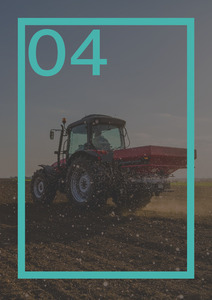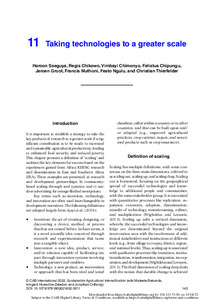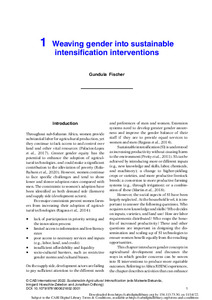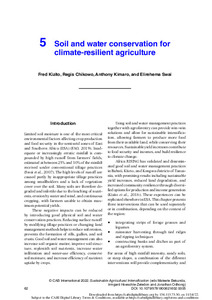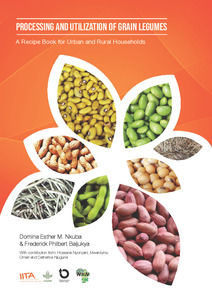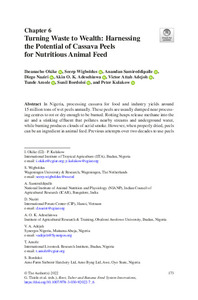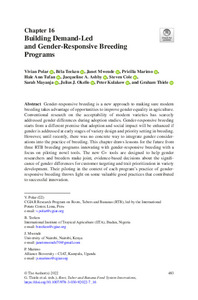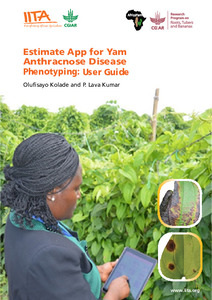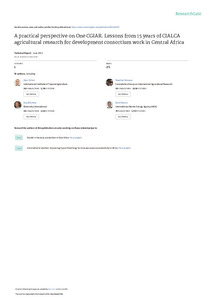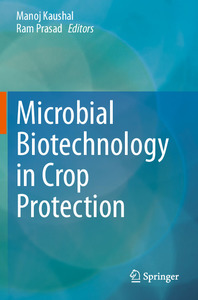Welcome to the International Institute of Tropical Agriculture Research Repository
Books and Book Chapters: Recent submissions
Now showing items 41-60 of 983
-
Opportunities for better phosphorus use in agriculture
(UK Centre for Ecology and Hydrology, 2022-05)Low phosphorus use efficiency (~20%) and high phosphorus losses from agricultural land to waterbodies is a growing global problem and exacerbated by climate change and rainfall extremes. Fertiliser use can be optimised and should consider all nutrients. Widespread soil phosphorus testing is required. In some regions appropriate control limits on phosphorus inputs will be needed, whilst in others an increase in P inputs will be required to improve/maintain agricultural productivity. An integrated ... -
Transforming yam seed systems in west Africa
(Springer, 2022)The availability of clean planting materials and functional seed regulatory systems is indispensable for fostering a sustainable seed yam system. The Yam Improvement for Income and Food Security in West Africa (YIIFSWA) project of the International Institute of Tropical Agriculture (IITA) developed the capacity of National Agricultural Research Institutes (NARIs) in their use of standardized Temporary Immersion Bioreactor (TIB) and Vivipak (VP) systems for high-ratio propagation and post-flask ... -
Use case activity review
(2021-11-29) -
Inoculant formulation and application determine nitrogen availability and water use efficiency in soybean production
(IntechOpen, 2022-02-22)Inoculation of suitable rhizobia enhances biological nitrogen fixation in soybean production and are economically viable for use among smallholder farmers due to its low price over inorganic commercial fertilizer blends. In Mozambique, inoculants are available in liquid or solid form (powder/peat or granular). Field studies were conducted in 2017 and 2018 seasons in three agroecologies (Angonia, Nampula and Ruace) in Mozambique to evaluate the performance of inoculants when applied directly to ... -
Use of genome sequencing for crop improvement in sub-Saharan Africa
(CAB International, 2022-07-07) -
Sustainable agricultural intensification: a handbook for practitioners in east and southern Africa
(CAB International, 2022-05)This book provides an insight into the background, lessons learned, and the methodology of facilitating the application of best-bet/best-fit agricultural technologies to smallholder farms in East and Southern Africa (ESA). All technologies highlighted within this book, except those on livestock feeding, were trialed and demonstrated in farmers' fields over an eight-year period [2012-2020] as part of the Feed the Future/USAID funded research-for-development Africa RISING ESA Project and supported ... -
Combining multiple technologies: integrated soil fertility management
(CAB International, 2022-05)This chapter shows how Integrated Soil Fertility Management (ISFM) can be combined and integrated further at farm and landscape levels to improve farming system performance. ISFM is an example of a system-wide technology. It is a set of soil fertility management practices, including use of industrial fertilizer, organic inputs, and improved crop varieties, combined with knowledge on how to adapt the practices to local conditions. Its benefits include agronomic efficiency, enhanced productivity, ... -
Taking technologies to a greater scale
(CAB International, 2022-05)This chapter presents a definition of 'scaling' and outlines the key elements for success based on the experiences gained from Africa RISING research and dissemination in East and Southern Africa (ESA). Three examples are presented: (a) research and development partnerships; (b) community based scaling through seed systems; and (c) outdoor advertising for orange-fleshed sweet potato. It presents experiences and lessons learned from using these approaches to transfer and scale the technologies. -
Improved technologies for reducing post-harvest losses
(CAB International, 2022-05-10)This chapter outlines several post-harvest loss reduction technologies validated by the Africa RISING program that will improve the efficacy of drying, threshing, and storage operations, and gives evidence of their potential impact. The chapter also provides evidence on the cumulative benefits of combining all three technologies. -
Management of soil fertility through application of fertilizers
(CAB International, 2022-05)This chapter presents technologies for replacing the nutrients lost from cropped fields with external fertilizer sources in a manner that minimizes the consequences of too little or too much application. The technology of using industrial fertilizers, organic fertilizers, and application of farmyard manure and compost alone or in combination with industrial fertilizers are discussed in detail. -
Weaving gender into sustainable intensification interventions
(CAB International, 2022-05)Sustainable intensification (SI) is understood as increasing productivity without causing harm to the environment. SI can be achieved by introducing more or different inputs (e.g., new knowledge and skills, labor, chemicals, and machinery); a change to higher-yielding crops or varieties, and more productive livestock breeds; a conversion to more productive farming systems (e.g., through irrigation); or a combination of these. This chapter introduces gender concepts in agricultural development and ... -
Soil and water conservation for climate-resilient agriculture
(CAB International, 2022-05)This chapter describes soil and water conservation measures for climate-resilient agriculture. It presents three interventions that can be used separately or in combination, depending on the context of the region: (1) integrating strips of forage grasses and legumes; (2) rainwater harvesting through tied ridges and ripping techniques; (3) constructing banks and ditches as part of an agroforestry system. The description of each technology, its benefits and application are discussed. -
Environmental and Social Impact Assessment (ESIA) of Ijaiye Agribusiness Industrial Hub (IAIH) project
(Agroinfotech Consulting Limited, 2022) -
Processing and utilization of grain legumes: a recipe book for urban and rural households
(IInternational Institute of Tropical Agriculture, 2022) -
Turning waste to wealth: harnessing the potential of cassava peels for nutritious animal feed
(Springer, 2022)In Nigeria, processing cassava for food and industry yields around 15 million tons of wet peels annually. These peels are usually dumped near processing centres to rot or dry enough to be burned. Rotting heaps release methane into the air and a stinking effluent that pollutes nearby streams and underground water, while burning produces clouds of acrid smoke. However, when properly dried, peels can be an ingredient in animal feed. Previous attempts over two decades to use peels in animal feed ... -
Building demand-led and gender-responsive breeding programs
(Springer, 2022)Gender-responsive breeding is a new approach to making sure modern breeding takes advantage of opportunities to improve gender equality in agriculture. Conventional research on the acceptability of modern varieties has scarcely addressed gender differences during adoption studies. Gender-responsive breeding starts from a different premise that adoption and social impact will be enhanced if gender is addressed at early stages of variety design and priority setting in breeding. However, until recently, ... -
Estimate App for yam anthracnose disease phenotyping: user guide
(IInternational Institute of Tropical Agriculture, 2021) -
A practical perspective on One CGIAR. Lessons from 15 years of CIALCA agricultural research for development consortium work in Central Africa
(2021-06)This perspective paper complements the Special Issue, by taking the five Challenges and Recommendations to One CGIAR as a starting point, and grounds those recommendations in the 15 years of AR4D practice of the Consortium for Improving Agriculture-based Livelihoods in Central Africa (CIALCA). CIALCA is a longstanding consortium of CGIAR centres and regional and national research and development partners that aims to accelerate the impact of agricultural research for sustainable development and ... -
Examining choice to advance gender equality in breeding research
(International Food Policy Research Institute, 2021) -
Microbial biotechnology in crop protection
(Springer International Publishing, 2021)

